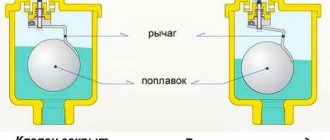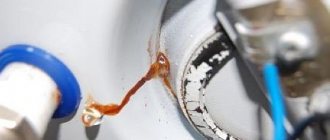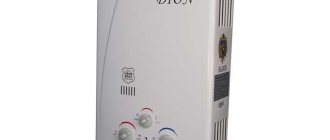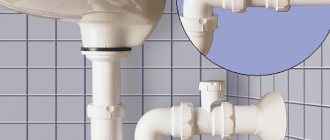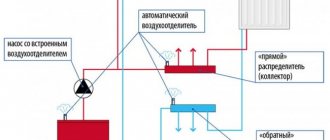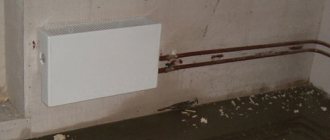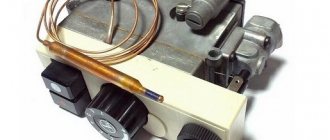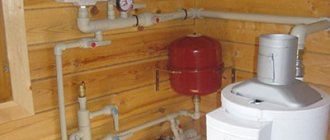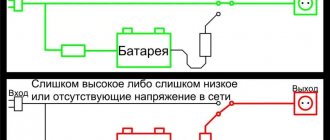Heating systems with water coolant very often become airy. Air penetrates massively into the liquid medium when heating networks are fed, and in addition is released from the water in different temperature conditions. In high areas of the network sections, air also collects, forming air plugs, which, depending on their size, can either completely block the circulation of water movement, or significantly limit it, thereby reducing the level of heat transfer, and therefore the efficiency of the system as a whole.
Air pockets can also be located in the heating source, which is especially dangerous and leads to serious accidents on boiler units. In this connection, there is a need for timely discharge of air from the internal circuit of the network using air vents. This is one of the main tasks of safe operation of heat supply systems.
Why does air appear in the heating system?
To relieve air accumulations in the pipe system, both inside the house and in the supply system, it is planned to install specialized taps - air vents.
Heat pipes can become airborne due to the following key points:
- When quickly filling a pipe system with water. Air collects in high places. Therefore, it is necessary that the process proceed slowly, the make-up entry point is located at the bottom, and the air outlet is at the very top of the system, usually in the attic.
- Increased solubility of gases in the coolant as its temperature increases. To feed large volumes of district or main heating networks, it is recommended to deaerate water in special bubbling-type devices. When the water temperature reaches 104 C, oxygen from the water escapes into the atmosphere through the deaeration column.
- In the process of carrying out repair and restoration work related to the drainage of coolant from a section of the network.
- As a result of corrosion processes, hydrogen is released on the internal surfaces of steel pipes, which gradually accumulates in heating networks.
- If the integrity of the heating system is compromised.
Incorrect security group setting
It is installed on the feed. Due to ignorance or illiteracy, many, when installing a safety group, place a shut-off valve between the boiler and the safety group (Fig. 1),
or directly to the security group (Fig. 2),
arguing that if the boiler fails, it will be possible to replace it or carry out repair work. In both cases, the installation was carried out incorrectly and, if the boiler fails, the service centers will refuse you warranty repairs, arguing that the boiler was installed incorrectly: this arrangement of the valve makes it possible for the system to overheat and the boiler to fail in case of shutdown shut-off valve by workers, third parties or children.
Why is air in a heating system dangerous?
Oxygen dissolves in water and increases the corrosiveness of the coolant, which interacts with the metal surfaces of pipes, radiators, pumps and boilers, thereby causing structural damage.
In addition, significant air pockets prevent the heating system from functioning effectively:
- It has the properties of a heat insulator, and if a plug has formed in the upper zone of the battery, it will begin to poorly perform its functions of transferring heat energy into the room.
- Electric pumps are designed to circulate coolant water and are not capable of pumping air. The pump will overheat, and the impeller and bearings will fail.
- The coolant, which has many air zones, operates very noisily, creating discomfort for others in the room.
How to remove an air lock
Before bleeding air using special fittings - air vents, you will need to diagnose the technical condition of the heating network, paying special attention to leaks. If found, they will need to be eliminated. In systems with forced circulation of the coolant, the electric pump is also subject to inspection; it is advisable to carry out maintenance on it first.
Algorithm for draining air pockets from the intra-house heating network:
- Stop the source of thermal energy.
- After it has cooled, turn off the smoke exhauster and fan, as well as the circulation pump.
- The power supply to the pump and boiler is turned off.
- The boiler water supply to the network is closed.
- All air vents are opened one by one.
- After the coolant pressure in the line drops to O, the internal heating circuit is fed to the operating pressure in the network.
- The operation is repeated until air is completely removed from the installed air vents.
- After eliminating the air locks, I start the system in reverse order.
Operating principle of an air valve in heating networks
There are two types of air vents - manual, which releases air with human participation, and automatic, which operates independently.
The automatic air vent for heating is made of a brass body. There is a plastic float in the middle. A valve is connected to it, on which the liquid medium presses.
The principle of operation of a self-acting vent in heating systems is as follows:
- While the devices are in the normal locked state, the housing is filled with working fluid, which puts pressure on the float and presses it into the upper position. In this option, the air valve is closed.
- When air appears in the chamber, the coolant level drops, so the float is forced to fall.
- In the process of reaching a critical level, the valve opens a passage to discharge accumulated air outside.
- After deep displacement of the air volume, the mechanism returns to its original state.
- During the initial filling of the heating main with water, air is discharged continuously until water enters the device body, which will act on the spring and, accordingly, on the valve, which will close the air discharge hole.
Device
The design of the automatic air vent is enclosed in a metal case (bronze, brass, stainless steel), at the bottom of which there is a connecting pipe. The body is sealed and can be cylindrical or cone-shaped. In our country, we have established the production of air vents with external connecting threads 1/2” (DN15) and ¾” (DN 20), in rare cases you can find 3/8”. Inside the barrel there is a float made of polymer material or stainless steel. Through the rocker arm (lever), the float is combined with a spool (spring-loaded drain valve), on the fitting of which a locking cap is placed. In general, the part looks like this:
Purpose and types of air vents
Autonomous heat supply systems, as well as heating devices connected to the main network, are equipped with specialized air vent valves. The most common among them are the Mayevsky manual valve and the automatic air valve.
There are 3 types of air valves sold in the retail chain:
- Traditional straight type, with vertical installation.
- Angular 90 degrees. They are used on heating appliances as an alternative to the Mayevsky tap, when the design of the heating pipework does not allow direct modification.
- Specialized air vents for heating devices.
Corner and radiator air vents
In various heating systems, sometimes a situation arises when it is necessary to vent air in inaccessible or remote areas. Where it is not possible to install a traditional type of air valve for heating, therefore a corner structure is installed. The angle valve has a special lower pipe with a rotation angle of 90 C and is capable of connecting to a horizontal section.
It should be noted that the corner design with an external threaded connection is practically no different from a conventional vent and can be used instead, if necessary.
Where to install air vents correctly
In various heat supply schemes there are areas where the installation of air vents is mandatory. In a professionally executed version of the heating network, installation locations are indicated according to the heating network design. There are general approaches to the placement of such protective devices. For example, Mayevsky taps are attached to all heating devices to release accumulated air. Insertion point - in the upper corner plug, remote from the point of connection of the supply pipe to the heating device, air collects in this area. When the boiler unit is equipped with a built-in air vent, it is not installed on the supply pipe.
An automatic air vent for heating must be installed vertically in the following places in the heating network:
- Safety unit for a boiler operating in a closed heating network.
- On the supply and return manifolds of the “warm floor” system.
- If in the intra-house wiring of the heating network, the highest point is a pipeline, and not a battery, then a float vent is mounted in it.
- Installation of an expander and an indirect heating boiler into the tank is carried out when this is provided for in the design scheme.
- On a hydraulic arrow, to separate the heating circuits in the house.
In addition to the noted zones, air vents are installed in problematic areas of the heating network, where, due to the difficult circumstances of installing pipes of different diameters, P-compensators of the upper direction are formed. In particular, when pipes go around doors or a flight of stairs, and then go down again. In such devices, air accumulates in 100% of cases, for this reason, in such places an air vent is needed, preferably an automatic one.
In intra-house heating circuits of multi-storey buildings, air vents are installed:
- At all collector sites
- On vertical P-compensators.
- At the highest point of the network of each riser of a multi-story building.
Choosing an air vent: expert advice
Such an important mandatory safety device for any heating network as an automatic air vent for heating must be chosen correctly.
It is usually supplied complete with other boiler equipment. If the home owner still has to choose an automatic air vent on his own, it is recommended to pay attention to the quality of the material from which the valve is made. It is necessary to protect yourself from all kinds of silumin fakes that imitate copper modifications. Professionals recommend choosing automatic devices with exhaust pipes directed upwards. According to reviews from numerous customers, on models with side outlets, leaks occur much earlier.
In addition, during installation it is necessary to ensure the vertical position of the device. Main recommendations for selecting air vents:
- It is more reliable to purchase a motorized air vent with a plastic or iron handle; this eliminates the need to carry various keys or screwdrivers with you. This faucet is convenient to use even in hard-to-reach places.
- In the case where young children live in the apartment, it is recommended to install an ordinary manual air vent, made for screwdriver control. Otherwise, children will be able to unscrew the air vent with a handle and scald themselves with boiling water.
- It is advisable to purchase devices with a self-acting cut-off device.
- If the estimate allows, it is possible to order a mechanism with additional options that can make servicing the heating network more comfortable.
- The high-quality anodized coating of the air vent essentially plays absolutely no role, but only reduces the level of rust formation on metals.
- Today in the retail chain it is possible to find combined modifications of heating network devices, which are also equipped with air vents. This list includes balancing valve devices, a variety of shut-off and safety valves and electric coolant circulation pumps.
The automatic vent valve does not work - what to do?
Problems with manual and automatic valves not working are mainly caused by poor quality of heating water. Scale often forms on the internal needle of the device, which is the result of the presence of hardness salts in tap water. As a result, the valve does not close the outlet hole tightly, and the device becomes a source of leaks. Such a failure can be easily corrected - unscrew the housing cover, clean the needle and the rest of the mechanism from scale and reassemble the structure. Only this will help for a short time, the problem will be resolved until subsequent scale formation on the key parts of the automatic air vent for heating.
Another common malfunction is the wear of the air vent O-ring. In this case, heated water will leak out from under the lid. The air vent can be repaired simply: replace the seal or wrap fum tape around the threaded connection of the housing.
Mechanical
The body of a manual release is usually made of brass, has a simple design and small size. The main part of the entire Mayevsky faucet is a needle-type shut-off valve. To engage it and expel air, you need to turn the screw counterclockwise one turn with a special key, screwdriver or hand, depending on the model of the device. The needle opens a hole and gases escape through it. At this point, a faint hissing sound will be heard. As soon as all the air has escaped, coolant begins to flow out through the hole. After this, you need to tighten the screw all the way.
The only drawback of mechanical devices is that all operations with them have to be carried out manually.
Link to video to text
A completely simple but important device - the air vent valve in the heating system performs an important function. The reliable circulation of the heating medium and the efficient operation of the heating network installation as a whole depend on its presence in the circuit. Moreover, the device is part of the so-called safety group, since it helps to automatically release air. The installation locations for vents are indicated by the heating network design. The same document establishes the standard size and modification of the protective device. Many types of heating equipment, including boilers running on gas fuel, are equipped with air vents already at the factory, during the assembly of devices and units.
Installation of Mayevsky crane
For the Mayevsky crane to operate efficiently, it is necessary to ensure its correct installation. The air vent is installed on a bimetallic or aluminum Ogint radiator without any problems, since its thread size corresponds to standard hole sizes. The main thing is to choose the right installation location. The Mayevsky tap must be installed in the upper radiator foot on the side opposite the coolant inlet.
The Mayevsky tap has a high-quality o-ring that seals the installation site. Also, for additional reliability, it is recommended to use FUM tape during installation.
In addition to radiators, air vents can be installed on heated towel rails.
